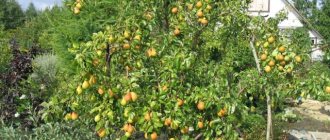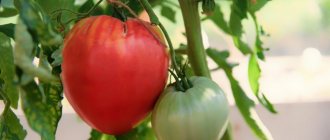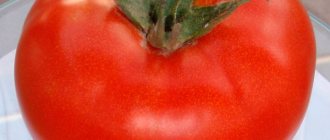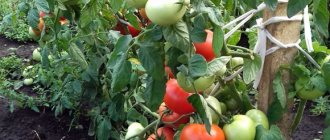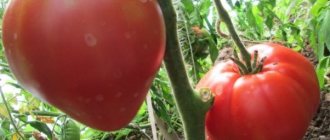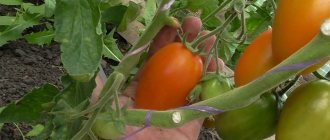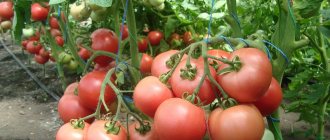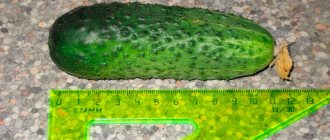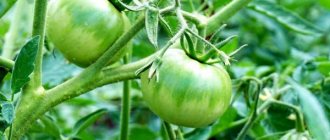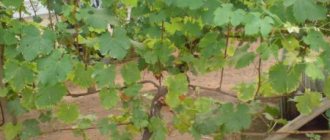How to choose the right tomato varieties for your plot?
I'll give you a couple of recommendations from personal experience.
If possible, first of all it is worth studying the experience of neighbors from the immediate area. Sometimes they have old, so-called “family” varieties that are passed down from generation to generation. These varieties are best adapted to the conditions of a particular area.
Also, when choosing varieties, you should take into account the climatic conditions and soil conditions on the site. On poor soil in open ground, residents of northern regions should not count on a good harvest from tomato varieties originating from warm countries (such as Mexican and Yusupovsky). You can’t do without a greenhouse here, and the beds in it should have fertile soil.
You also need to consider how much time you can devote to tomato bushes. If it is not enough, then it is better to focus on unpretentious varieties that are less demanding on the level of agricultural technology. There are many of these, for example, among domestic varieties of Siberian selection.
If you look for seeds on my website, focus on the above “favorites”. And among my interesting new products I can mention the following varieties (below is a table with photos).
| Sgt. Pepper is a wonderful, productive American variety. Tall (2 m), medium ripening. The fruits are medium-sized, heart-shaped, blue-red in color. Very tasty, fleshy, sweet, with sugary pulp. |
| Beauty King is a tall tomato variety from Brad Gates. The fruits are beautiful, large, red-orange in color with shading. Very tasty, sweet, with fruity sourness. A productive variety. |
| Bleeding Heart is a tall tomato variety from Brad Gates. The fruits are beautiful, medium in size, red-orange in color with shading. Very tasty, sweet, with fruity sourness. A productive variety. |
| Love Heart is a tall tomato variety from Brad Gates. The fruits are very beautiful, heart-shaped, medium in size, crimson in color with shading. There is a purple spot near the stalk. Juicy, meaty, sweet, aromatic. |
| Pascal de Picardie is a very beautiful variety. Tall (2 m), medium ripening. The fruits are medium-sized, plum-shaped, crimson with anthocyanin spots. Very tasty, meaty, sweet, with a taste of exotic fruits. |
| Banana legs are a popular mid-early ripening variety. The height of the bush is about 1 m. The fruits are medium in size, pepper-shaped, yellow in color with light stripes (the stripes are clearly visible on green fruits and are difficult to distinguish on ripe ones). The fruits have excellent taste, sweet (sometimes with sourness), juicy and fleshy. |
| Kibits is a medium-sized (1 m) productive variety with an average ripening period. The fruits are small, red, and pepper-shaped. Sweet, juicy and fleshy, with sugary pulp. |
| The Ussuri Tiger is a tall (2 m or more) productive variety with a medium ripening period. The fruits are medium-sized, yellow, streaked, round in shape. Sweet, juicy, with sourness. |
| Church (Church) is a tall (2 m), productive variety from the USA with an average ripening period. The fruits are very large, pink, flat-round in shape. Very tasty, sweet, meaty, sugary. |
| Juvel is a tall (2 m) productive variety from Canada with a medium ripening period. The fruits are large in size, flat-round in shape, and crimson in color. Excellent taste, sweet, meaty. |
| Japanese is a tall (2 m) productive variety of medium ripening. The fruits are large, heart-shaped, pink in color. Excellent taste, sweet, meaty, tender, sugary. |
| Vorlon is a tall (2 m) variety with a medium ripening period. The fruits are large, purple, flat-round in shape. Very tasty, sweet, juicy and meaty. |
| Kumato is a tall (2 m) variety with medium ripening period. The fruits are medium size, purple in color, round in shape. Sweet, juicy and meaty. |
When is the best time to buy seeds? I believe that in the fall, when they first appear on sale, this is the time when the choice is greatest. Later, individual varieties are sorted out, and by spring the assortment is already noticeably thinner.
In any case, I wish you to choose and buy exactly those tomato seeds that will bring you a lot of joy and give you an excellent harvest!
Do you have any questions, want to leave/read a review about this or that variety, or just thank the author for the interesting material? Visit Ilya Korolev’s website.
Description of the variety
American breeder B. Gates introduced the Amethyst Jewel to the world in 2013. Unfortunately, the variety was released somewhat prematurely, “unstable.” It is precisely because varietal characteristics have not been fixed that tomatoes are very variable in shape, weight and color from different seed sellers.
The breeder himself declares the following characteristics of the tomato:
- weight 30-85 g;
- quantity in brush 5-7;
- round fruits;
- The color of the tomatoes is pink with blue streaks at the base;
- the productivity is high.
However, a lot has changed since 2013, and the variety has decisively expanded the boundaries of the described standards. The weight of its fruits ranges from 30 to 250 g; bush height from 1.3 to 2.5 m; Outwardly, tomatoes can be either round or irregular in shape. The only thing you can be sure of is the yield – it is consistently high.
The anthocyanin pigment (responsible for the ink shoulders of the tomato) endowed the Amethyst Jewel with its special charm and taste. If the tomatoes receive more sunlight, the color will be a rich, dark purple. Tomatoes deprived of sunlight will show more pink.
The cut flesh is red-pink, fleshy, with a moderate amount of seeds. The taste is piquant, enveloping, with a delicate fruity note.
According to ripening time | By type of growth | By type of use | By growing method | Fruit weight (g) | Productivity (kg/m2) | Fetal characteristics |
| Mid-ripe, 110-115 days | Indeterminate, 180-250 cm | Universal | For greenhouses and open ground | Up to 250 g | Greenhouse: 6-9 kg Open ground: 5-7 kg | Pink-purple, round and irregular in shape |
Description of the bush and fruits
Tomato hybrid 6 Tarasenko
The characteristics of the bush are indeterminate, reaching a height of 150 centimeters. Mid-early, 115–125 days pass from planting seeds in the ground to receiving the first harvest. It is heavily leafy, so during growth it is necessary to thin out the leaves so that they do not shade the fruits and slow down ripening. The variety was developed by a family from Kostroma back in 1960. The first inflorescence is formed above the sixth leaf, the next ones - after two leaves.
Medium sized fruits. Large fruits, whose weight reaches 200–250 grams, have a slightly ribbed surface. Some vegetables reach a size of 300 grams. When unripe they are light green, when ripe they are dark red. When cut, there are from 6 to 9 nests in a tomato. The pulp is valuable - dense, juicy, pink in color.
Description of fruits
- Fleshyness combined with a small amount of seeds is the main property that will delight consumers. What is also attractive is that, despite the color of the tomato shell, the inner cavity has a bright red tint, filled with juice and rich taste.
- The tomato flavor of the fruit is ideally combined with a slight fruity note, resulting in sweetness and spiciness.
- The fruits are not large, so the weight is no more than 200 grams, but the combined weight of several fruits growing on one branch can cause damage to the stem, so tying is necessary to evenly distribute the load.
- Due to their dense peel, the fruits can withstand long-term storage or transportation, so if all conditions are created, you can enjoy the taste of tomatoes for a long time.
- This type of tomato is ideal for salads and preserves due to its structure and spiciness. If we talk about preservation, the fruits will not crack or deform, which allows them to ideally retain their basic taste and aromatic properties for a long time. The variety has proven itself in creating culinary masterpieces due to its appearance and taste.
Are there any secrets (tricks) to getting a great tomato harvest?
Tomato raspberry flame
Certainly! When growing tomatoes, you should not only provide proper care for them, but also take measures to increase the yield. There are many secrets, for example:
- Strengthening the root system. It must be remembered that the larger and stronger the roots of a tomato bush, the more fruits they can nourish and grow. The same hilling and mulching will help strengthen the rhizome.
- Spraying with boron, which promotes pollen absorption and ovary formation. A weak solution of boric acid (5 g per 5 liters of water) is suitable for this.
- Regular stepsoning. The absence of stepsons is a guarantee that all nutrients from the soil will be supplied to the stem and from it to the fruit.
- Remove lower leaves weekly.
Temperature and placement
For proper development of seedlings, they should be kept in a bright room with a temperature of 23-24 °C. Then they begin to gradually reduce it. This promotes the development of the hands.
After a couple of weeks, the temperature is lowered to 19 °C during the day and 17 °C at night. This is how the first brush is formed. It is necessary that it forms between the 9th and 10th sheets. Otherwise, the harvest volume will be greatly reduced.
When transporting seedlings, tomatoes should be protected from drafts and sudden temperature changes. Seedlings are transported in a vertical position, covered with film.
When planting seedlings in the ground, the soil is moistened. When placing on the garden bed, maintain an interval of 51-56 cm between the bushes. The width of the path between the ridges should be 70-80 cm.
Experienced gardeners advise arranging bushes in a checkerboard pattern, this makes it easier to care for them.
When planting seedlings in the ground, the soil is moistened. When placing on the garden bed, maintain an interval of 51-56 cm between the bushes. The width of the path between the ridges should be 70-80 cm.
Growing and care
Conduct intervarietal crossing of tomatoes
Sowing of seeds is carried out 60-65 days before planting in the ground. The seeds have good and abundant germination, so when sowing in a common container, you will need to plant them in separate pots or freer containers.
The characteristics of the variety indicate that the stems of the sprouts are characterized by a bluish tint.
“Amethyst Jewel” does not tolerate temperature changes very well, so young shoots must be protected from drafts and overheating of the air. It is recommended to plant bushes at a density of 3-4 plants per square meter.
After planting in the ground, tomatoes will not require special care, except for timely watering, weeding, hilling and periodic feeding.
As it grows, the bush should be formed into 2-3 stems. The plant will also need staking and careful pinching. You can increase the immunity of a tomato plant by mulching the soil with wood chips, pine needles or sawdust.
Sunlight plays a big role in the color of Amethyst Jewel tomatoes: the more light that falls on the fruit, the darker its color will be. Therefore, if you grow "Amethyst Jewel" in the shade, the color of the tomatoes will not have such a rich purple color, but will be more pink.
This tomato treasure will amaze with its extraordinary color, surprise with its fertility and will not disappoint with its sweet taste.
Distinctive features of the variety
Amethyst rhinestone is a variety characterized by high fruiting, which ensures a high yield of product per square meter. However, an interesting fact is that when grown in open ground, seedlings can reach half a meter in height. And that is why special tightening is required when growing to avoid overloading and even damage to the bush.
There are the following features when growing tomatoes of the Amethyst Treasure variety:
This tomato variety has an average ripening speed (as a result, 100-115 days after planting, you can pick juicy and tasty fruits
But this feature applies only to greenhouse cultivation of fruits, since in such conditions optimal temperature and humidity are created, for which reason it has a positive effect on subsequent yields. High yield is an important positive quality, which became the basis for the development of demand for this product. Healthy plant clusters can provide mainly 5 dense fruits filled with juice and nutrients. Seedlings can bear fruit until September, and if we consider growing in a greenhouse, the period increases significantly. Produces dense and tasty tomatoes, filled with a bright red color, which creates attractiveness combined with richness of taste. A plant from a nearby selection was vaccinated against various diseases, so Pomona’s gifts will delight you with their taste and aroma
And the process of growing uninhabited (= sparsely populated) is accompanied by diseases and infections of the plant. Even the most persistent diseases of the plant will not cause disruption of flowering and fruiting of tomatoes.
Also, transplants cope with temperature changes; hot days and cold nights will not create difficulties for the plant, and fruiting will be at a high level. But active fruiting is ensured by maintaining a temperature above 25 degrees Celsius.
Rules for growing Amethyst Jewel
The plant requires special agrotechnical growing conditions. Experts recommend following the following tips to get a high-quality harvest.
Preparing seeds for planting
Start sowing seeds two months before the expected date of planting the seedlings in the ground.
Before sowing, the seeds are placed in a damp cloth or gauze for a day and placed in a cool and dark place for germination. To prevent infection with fungal diseases, soak them in a solution of potassium permanganate before sowing. Well-prepared seeds germinate quickly and promptly.
Preparing the soil for tomatoes
Prepare the soil mixture in advance. The easiest and most proven way is to buy special soil at a gardening store. You can also prepare the soil yourself from peat, garden soil, sand and drainage.
Before sowing seeds, it is recommended to disinfect both store-bought and home-made soil. There are two ways:
- heat in the oven at 200 degrees for 10 minutes;
- pour boiling water or potassium permanganate solution.
Seed planting scheme
After disinfecting the soil and seeds, proceed to planting. Pre-moisten the soil, plant the seeds in even rows at a distance of 10 cm between them. Sprinkle the planting material with soil no more than 3-5 mm. Cover the boxes with glass or film until the first shoots appear. If the soil dries out, moisten it with a spray bottle.
Growing rules
The Amethyst Jewel tomato is a rather unpretentious variety. By following the basic rules of agricultural technology, the plant will actively grow, develop and delight the owner with an abundant and high-quality harvest.
Planting seedlings
Amethyst Jewel tomato seeds should be planted approximately 2 months before transplanting the seedlings to a permanent location. Before sowing, it is necessary to prepare the planting material:
- Disinfect the seeds. Store-bought grains do not require this procedure. However, if the material was collected independently, it must be soaked in a special solution. It can be prepared by mixing water with potassium permanganate (1 g per 100 ml), soda (0.5 g per 100 ml) or aloe juice (50 ml per 50 ml).
- Disinfect the soil. If the soil was not purchased in a store, it also needs to be disinfected. The earth can be heated in the oven (200°C for 10 minutes) or microwave (at 850 power for 1 minute). The soil can also be disinfected using boiling water or a powerful solution of potassium permanganate.
After disinfecting the planting material, you should begin sowing seeds for seedlings. Tomato grains must be laid out in rows on moist soil. Next, the material should be sprinkled with a small amount of earth. The layer should not be more than 5 mm. After this, the soil should be slightly moistened with a spray bottle.
Containers with plantings should be covered with glass or film material. The container should be in a warm room until the first shoots appear. After this, the glass or polyethylene must be removed.
When leaves appear on each sprout, they need to be carefully transplanted into separate containers.
Transfer
Amethyst Jewel tomato sprouts should be planted in groups of 3-4. per 1 sq. m. If they are placed even closer, this will negatively affect the fruiting of the tomato. It will produce fewer crops with lower quality.
It is necessary to transplant seedlings to a permanent place at the end of spring, when the night temperature stops falling below zero.
The soil for cultivating tomatoes of this variety must be water- and breathable. Ideally, it is better to prepare it in the fall, fertilizing it well with ash, eggshells and compost.
Before planting tomato sprouts, the soil must be loosened. 10 g of superphosphate should be placed in the dug holes.
After replanting the sprouts, the soil should be moistened abundantly with settled warm water.
Aftercare
The Amethyst Jewel tomato variety is unpretentious. Caring for tomatoes includes such standard measures as moistening and loosening the soil, tying, weeding and fertilizing.
It is necessary to build trellises over the beds with tomatoes of this type, which will allow tying up the stems of the bush as it develops. Their height should vary between 1.8-2 m.
Amethyst Jewel tomatoes should be fertilized in 3 stages:
- 10 days after transplanting the seedlings. At this stage, it is best to use ready-made nutrient mixtures “Gumisol” or “Vermistim”. Bird droppings will also work.
- 14 days after the formation of ovaries on 2 clusters of the plant. This time the tomato needs to be fertilized with a mixture of chicken manure solution, 1 tbsp. l. “Mortar”, 3 g of manganese and 3 g of copper sulfate.
- At the beginning of harvesting ripe fruits. The bush at this stage again needs the combined composition that was used during the 2nd feeding.
Agricultural technology varieties
When grown in a greenhouse, fruits may be affected by gray rot (those removed will rot at the stalk). The variety is practically immune to fusarium, late blight and other diseases common in central Russia. But domestic vegetable growers should be aware that it is very demanding on weather conditions: the yield of Amethyst Jewel is reduced both at too high and at low temperatures.
The optimal interval for growing is +22…+25 °C. In regions with cold summers, it is better to cultivate tomatoes in greenhouse conditions.
The germination rate of purchased seeds is not very high: out of 10 seeds sown. most often 4-6 sprouts sprout. This must be taken into account when purchasing planting material. Sowing is carried out at the end of March, using standard technology:
- moisten the soil in the container generously;
- spread the seeds over the surface;
- sprinkle with dry soil;
- Cover with glass and place in a warm place until germination.
Plant seedlings at the stage of 2 true leaves. Plant in a permanent location in mid-May or early June.
How to tie up tall varieties
Trellis are built over the bed of Amethyst Jewel tomatoes - structures that allow you to tie up the stems of the tomatoes as they grow. Typically the top crossbar is placed at a height of two meters. In greenhouse conditions, the stems of Amethyst Jewel can grow over 2 m.
Important! In order not to cut the very long stem of the Amethyst Jewel, it is thrown over the crossbar (wire) and fixed at an angle of 45˚. If the plant continues to grow vigorously, then at a level of 50-60 cm from the ground its top is pinched.
Transplanting seedlings
Transplantation of seedlings of the amethyst jewel variety (the original name of the crop) is done when several pairs of leaves are formed on the seedlings. The optimal time for replanting is the end of March, when the soil and air temperatures are in the range of 10-18 °C.
The soil should be nutritious, with a low level of alkali in its composition. The site is pre-fed with humus or peat at the rate of 10 kg of fertilizer per 1 m². After this, they dig holes 9-12 cm deep. A distance of 50 cm is maintained between the rows, and 60 cm between the bushes. This will make it easier for the gardener to care for the crop.
The transplantation process includes the following steps:
- 2 kg of wood ash is poured into the bottom of the hole and 5 liters of warm water are poured into it;
- when the water is absorbed, seedlings are placed in the depressions;
- they are densely sprinkled with soil and compacted;
- Water each bush with 3 liters of warm water.
Features of care
Caring for the Amethyst Jewel tomato variety is simple, and even beginners can follow the recommendations for it.
Watering
Water your plants on a regular schedule. Young bushes - at intervals of 3 days. Each time use 20 liters of warm water per 1 m². Adult plants need rare but abundant watering, so the procedure is carried out once a week, but 5 liters of water are poured under each bush.
():
When caring for plants, you need to focus on the weather, and not blindly follow the schedule. In hot weather, water more often, spending 5-6 liters per adult plant. In cool, cloudy weather, you can water once every 7-10 days.
2 weeks before harvesting, watering is stopped to facilitate the process of removing tomatoes from the bushes and reduce the risk of rotting.
Feeding
Fertilizers are applied at each stage of the growing season. During active crop growth, use nitrogen fertilizers (25-30 g of ammonium nitrate per 1 square meter of bed). At the stage of formation of ovaries and fruits, organic substances are used in the form of humus or compost (100 g of each is dissolved in 10 liters of warm water).
A week before harvesting the fruits, feed the bushes with phosphorus-potassium fertilizers (30-40 g per 1 square meter) to improve the taste of the tomatoes.
Feeding should be moderate. After watering and fertilizing, the beds need to be loosened and weeds removed. It is better to loosen the soil with a non-sharp tool, and remove weeds manually so as not to damage the bushes.
Garter and stepson
The Amethyst Jewel tomato does not need pinching, because shoots are formed in minimal quantities. The bushes need to be tied as they grow, so that the side shoots and main stem do not break off under the weight of the fruit.
Tomato Amethyst Jewel
THE BEST VARIETIES OF TOMATOES.. AMETHYST JEWEL
IS IT STILL WORTH PLANTING TOMATO VARIETY AMETHYST JEWEL IN A GREENHOUSE?
Brief information about the variety
- Fruits and bush: indeterminate bush type. In open ground they grow up to 1 m (in a greenhouse - twice as high). The fruits are medium-sized, round, weighing up to 200 g. Gradient colors - from black to deep red.
- Productivity: high. From 1 m², a gardener collects up to 20 kg of fruit. From each bush - 4-5 kg.
- Resistance: the variety is resistant to scab, root rot and late blight. Not subject to attacks by wireworms and mole crickets.
- Distribution: grown in all regions of the country. In the southern regions, planting in open ground is possible. In other regions they are planted in a greenhouse.
- Application: universal.
- Planting: seedlings are planted at the end of May, according to a 50x60 cm pattern.
- Soil: fertile and light.
- Care: watering – 4 times a month. Feeding - at all stages of the growing season. No pinning is required, but garters are required.
- Ripening period: the growing season lasts 3 months. The first fruits ripen in August. They are suitable for long-term storage.
Characteristics of the variety
Amethyst Jewel tomatoes have excellent characteristics. This variety has almost no disadvantages. It produces good yields, has a wide range of uses, and is also resistant to diseases and pests.
Productivity and fruiting
A mid-season tomato of the Amethyst Jewel variety becomes ready for harvest approximately 4-5 months after the first shoots appear. The duration of ripening depends on the conditions in which the tomatoes are grown.
This variety can be cultivated both in open soil and in a greenhouse. Tomato is characterized by long fruiting. In open ground conditions it will continue to ripen in September, in a greenhouse even later.
Area of application of fruits
In reviews of the Amethyst Jewel tomato variety, many note that vegetables can be used for a variety of purposes. These tomatoes, which have a pleasant taste and aroma, can be consumed both raw and processed. The fruits can be stewed, fried, canned, and also used to make juice. Tomatoes go well with meat dishes.
Resistance to diseases and pests
According to the description of the tomato variety Amethyst Jewel, the plant is absolutely resistant to all kinds of diseases and insect pests that often affect tomatoes of other varieties.
Advantages and disadvantages of the variety
Tomatoes of the Amethyst Jewel variety have many positive qualities, which include the following indicators:
- abundant yield;
- immunity to disease;
- pest resistance;
- excellent taste;
- pleasant aroma;
- transportation over long distances;
- possibility of long-term storage;
- attractive appearance;
- unusual colors;
- universal purpose;
- Possibility of cultivation both in open soil and in greenhouse conditions.
Among the disadvantages of this variety of tomatoes, the following characteristics can be distinguished:
- the need for garters;
- sensitivity to temperature changes.
Description of the tomato variety Amethyst Jewel and its characteristics
Recently, tomato experts have been increasingly interested in “bi-colors” - multi-colored tomatoes. A large number of exotic varieties were developed by the American breeder from California, Brad Gates, including such a tomato treasure as the “Amethyst Jewel” tomato.
Features of the variety
“Amethyst Jewel” is a universal tomato that is suitable for cultivation both in greenhouse conditions and in open ground. Original title: Amethyst Jewel.
This is a medium-growing indeterminate variety. The bushes are spreading, medium leafy.
- The “Amethyst Jewel” variety is characterized by medium ripening periods; it begins to bear fruit approximately 110-115 days after germination, subject to greenhouse maintenance.
- High yield is one of the main advantages. The ovaries are formed well, without gaps. Dense clusters of 5-6 fruits are formed.
- Fruiting lasts until September; in a greenhouse it can last even longer.
The plant is very resistant to most diseases, but is quite capricious to weather conditions. It is difficult to tolerate sultry heat and severe cold. The optimal temperature for tomatoes to develop normally and bear fruit abundantly is +25 degrees.
In Russia, this tomato variety is recommended to be grown in greenhouses, and only in the middle zone - in open ground. The description of the variety confirms this.
Description of fruits
The shape is flat-round. The skin is dense and smooth, not prone to cracking.
The tomato has an unusual color: from the shoulders, the deep purple color is splashed with blue-violet flashes to the warm pink color of the top.
- The flesh is fleshy, with a small amount of seeds, and when fully ripe has a rich red color.
- The tomato has a pronounced, enveloping tomato taste with exotic fruity notes.
- The size of the fruit is small or medium, no more than 200 grams.
- Tomatoes store well and are resistant to transportation.
“Amethyst Jewel” tomatoes look very interesting and unusual in salads and after preservation. This variety is excellent for wide use in cooking.
Growing and care
Sowing of seeds is carried out 60-65 days before planting in the ground. The seeds have good and abundant germination, so when sowing in a common container, you will need to plant them in separate pots or freer containers.
The characteristics of the variety indicate that the stems of the sprouts are characterized by a bluish tint.
“Amethyst Jewel” does not tolerate temperature changes very well, so young shoots must be protected from drafts and overheating of the air. It is recommended to plant bushes at a density of 3-4 plants per square meter.
After planting in the ground, tomatoes will not require special care, except for timely watering, weeding, hilling and periodic feeding.
As it grows, the bush should be formed into 2-3 stems. The plant will also need staking and careful pinching. You can increase the immunity of a tomato plant by mulching the soil with wood chips, pine needles or sawdust.
Sunlight plays a big role in the color of Amethyst Jewel tomatoes: the more light that falls on the fruit, the darker its color will be. Therefore, if you grow "Amethyst Jewel" in the shade, the color of the tomatoes will not have such a rich purple color, but will be more pink.
This tomato treasure will amaze with its extraordinary color, surprise with its fertility and will not disappoint with its sweet taste.
Description and characteristics of the variety
Indeterminate variety of tomatoes, reaching 180 m in height.
Medium-early, medium-leaved plant with spreading bushes. The original name of the variety is tomato 'Amethyst Jewel'. Recommended for cultivation in central regions due to suitable climatic conditions. The fruits are slightly flattened and round in shape. The tomato skin is quite durable, which prevents cracking. A distinctive feature is the color of the fruit - technically ripe tomatoes have a dark purple color, and fully ripe tomatoes have an almost black area near the stem with rays smoothly transitioning to a bright pink top. In cross section the fruits are pink in color.
The peculiarity of the variety is not only that the tomatoes have a non-standard coloring, but also that the stems can also have a bluish tint. Therefore, you should not immediately be afraid that the plant is sick.
Advantages and disadvantages of the variety
Despite the instability of the variety, the tomato has a number of advantages that set it apart from others:
- The tassels are tied very tightly, from bottom to top, without gaps. Each cluster produces 5-6 fruits.
- The skin is dense, cracking is not typical.
- High resistance to most tomato diseases.
- In open ground it grows spreading, no higher than 1.5 m.
- Fruiting is long-lasting - the harvest in the greenhouse can be harvested until the end of September, and even later in greenhouse conditions.
- Good shelf life (up to 2 months after harvest).
- The tomato is valued for its beauty and taste in salads and is excellent for processing.
The disadvantages include:
- ordering seeds only from private breeders;
- fluctuations in fruit weight;
- dependence of taste and appearance on the presence of sunlight.
Description
The tomato belongs to the mid-season category, the variety was bred in the USA. The height of the bush reaches 1.8 m; pinching is considered a mandatory condition for care. Ripe tomatoes have a round, flattened shape; the weight of one tomato reaches 200 g. The thick skin is prone to cracking, and the color of the fruit changes as it ripens.
Features of the variety:
- the possibility of growing in beds, in greenhouse conditions;
- spreading bushes of medium foliage;
- height 1.5 m in open ground;
- fruiting - after 110-117 days, long period of fruiting;
- resistance to long-distance transportation;
- disease resistance;
- increased productivity.
When grown in garden beds, the ripening period occurs in September; in a greenhouse, tomatoes ripen later. The main disadvantage of the variety is its sensitivity to weather changes. Tomato does not tolerate cold temperatures and dry air. The optimal temperature for the plant is 25 degrees. The middle strip is best suited for planting in the garden.
How to collect tomato seeds
The time for collecting seeds for seedlings is determined by the time the tomatoes ripen. The best time is in the middle of the period. Amethyst Jewel is a mid-season variety and grows from mid-August to early September. The optimal time is the end of August.
For seed tomatoes, the following are suitable:
- Mark strong and productive bushes, then use them to collect seed material;
- On the selected bushes, select fruits that best match the varietal characteristics in color, weight, shape, etc.
- Collect tomatoes from level 2-3 on the main stem;
- Pick the largest fruits without defects.
Collect seeds from selected tomatoes using the following algorithm:
- Cut the fruit;
- Scrape the seeds into a glass container of water at normal temperature and leave to ferment to get rid of the placenta and pathogenic bacteria;
- After 3 days, mold will grow on the surface, remove it carefully;
- Stir the contents and remove all floating seeds, do this several more times until the seeds stop floating. All floating seeds are empty, and there will be no harvest from them;
- Wash and dry the remaining seeds; good seedlings will sprout from them.
Place the finished seeds in paper or fabric bags or bags.
They should be stored in a dark, cool and dry place until spring planting. Be sure to indicate on the package the time of seed collection. Strong seeds are viable for 9 years.
Fertilizer varieties
To select the correct composition of fertilizers, you should take into account the composition of the soil and the climatic features of the area. Tomato Amethyst Jewel is fed three times.
- 10 days after planting the seedlings, tomatoes are fertilized with ready-made mixtures (“Gumisol”, “Vermistil”). Fans of organics can apply bird droppings at a rate of 1 part fertilizer to 10 parts water. The beds are mulched with grass and straw, this will help curb the growth of weeds.
- After the ovaries are formed, fertilize again after two weeks. You can use a solution of chicken manure with the addition of tbsp. spoons of “Solution” and 3 grams of manganese and copper sulfate. 2 liters of water with fertilizer are poured under each bush.
- When the harvest is harvested, another 2.5 liters of a similar composition are added under the bush.
To avoid burning the roots and simplify the fertilizing process, you should combine watering and fertilizing.
Tomatoes are resistant to diseases, as mentioned earlier, so additional measures to prevent them do not need to be taken. It is enough just to follow the rules of agricultural technology when growing the described variety.
- 10 days after planting the seedlings, tomatoes are fertilized with ready-made mixtures (“Gumisol”, “Vermistil”). Fans of organics can apply bird droppings at a rate of 1 part fertilizer to 10 parts water. The beds are mulched with grass and straw, this will help curb the growth of weeds.
- After the ovaries are formed, fertilize again after two weeks. You can use a solution of chicken manure with the addition of tbsp. spoons of “Solution” and 3 grams of manganese and copper sulfate. 2 liters of water with fertilizer are poured under each bush.
- When the harvest is harvested, another 2.5 liters of a similar composition are added under the bush.
The Amazing Fruits of the Amethyst Jewel
This exotic tomato variety belongs to the bicolor group. The color of the fruit combines 2 primary colors, as shown in the photo. Even in an unripe state, the fruits have a dark color on the shoulders (closer to the stalk), and the tip is lighter. The violet hue, continuous near the stalk, gradually splits into separate stripes and dots. When the fruit ripens, the dark color remains, but the tip becomes pink. The combination of colors is reminiscent of the play of shades of an amethyst gem, for which the variety received its original name.
Not all gardeners like the taste of ripe Amethyst Jewel tomatoes. Reviews agree on one thing: the fruits lack the sourness characteristic of tomatoes. The dessert's sweet, almost caramel-like flavor is distasteful to many. Therefore, this variety is not suitable for lovers of traditional tomatoes, but children will certainly like it.
The disadvantages of Amethyst Jewelry include:
- thin skin;
- property of cracking with sudden changes in temperature.
But tomatoes, collected completely intact, are distinguished by their high keeping quality and the ability to ripen in boxes within 1-2 months after being picked from the bush. This allows you to extend the period of eating fresh vegetables from your garden.
The average weight of the fruit is 130-200 g. The shape of the tomato is flat-round, suitable for canning in its entirety. Despite the thin skin, fruits in marinades retain a dense pulp consistency and do not fall apart. Amethyst Jewel tomatoes can also be used to make juice or lecho, since only the skin has an exotic color. The pulp is rich pink in color, with numerous small seed chambers. The unusual taste of the fruit is also suitable for making jam or preserves from tomatoes.
The variety is not a hybrid. Seeds from plants grown on your own plot can be left for the reproduction of the variety. But to preserve the color characteristic of Amethyst Jewel, these bushes should not be planted next to red-fruited varieties.
Reviews from summer residents
“I liked Amethyst Jewel because no other tomato has such an unusual caramel taste. This variety does not suffer from any diseases, so I gladly included it in my collection” (Natalia);
“I often experiment with new tomato products. Amethyst jewelry is excellent in both taste and appearance. Our family and guests were impressed with these tomatoes” (Elizabeth);
“The fruits of this variety are very attractive in appearance. I think this is one of the most beautiful tomatoes. It’s even difficult to say what color it is, more likely pink-blue. The bottom of the tomatoes are painted warm pink, and in the middle they are painted with blue-violet splashes. Truly a real gem. The tomatoes also surprised me with their taste. They weigh about 140 g.” (Alyona)
Original Amethyst Jewel tomatoes are a delicious addition to your summer diet. It is not difficult to care for the crop even for a novice vegetable grower. Cute fruits will become a real decoration for your garden plot.
How to grow seedlings
Sowing of seeds is carried out 60-67 days before planting young plants. Tomato seeds germinate together. The soil mixture is prepared in advance. It is better to buy it at a farm store. The seeds are laid out on a damp soil surface and sprinkled with a small layer of earth or peat chips. The top soil layer can be slightly moistened with a watering can.
To prevent the soil from drying out, you need to cover it with polyethylene or glass. Before emergence, the container should be in a warm room, at a temperature of +23.
After the sprouts appear, the protection is removed
As soon as leaves form, carefully move the seedlings into small containers
To grow strong bushes, you need to place 2 shoots in each glass. When their height reaches 13-15 cm, the stems are tied with nylon thread. They grow together, and the upper part of the weak plant is pinched. The result is 1 bush with a strong stem.
For proper development of seedlings, you need to keep the pots in a bright room. The temperature there should remain 23-24 degrees throughout the day. It can be reduced after 1.5-2 weeks. Then the first brushes of the Amethyst Jewel will develop correctly.
The temperature is reduced over two weeks: during the day to +19, at night to +17. You can’t rush and change the parameters suddenly; because of this, the first brush may not form correctly. In indeterminates, it should form between 9 and 10 leaves. Otherwise, yields may fall.
When moving seedlings, you need to protect them from drafts and temperature changes. Seedlings should be in an upright position and covered with polyethylene.
After transplanting tomatoes, you need to slightly moisten the soil. The bushes should be located at a distance of 51-56 cm from each other. The optimal distance between the beds is 70-80 cm.
The holes are made in a checkerboard pattern to make it easier to monitor the condition of the plants and fix them.
Growing seedlings
It is not recommended to plant seeds directly into the ground; first, seedlings are prepared, and then small seedlings are transplanted to a permanent place of growth. This could be a greenhouse or open ground.
How to plant seeds for seedlings
To avoid getting weak plants and removing emerging seedlings, plant seeds in peat tablets, cassettes or separate cups. Experts recommend planting two seeds side by side so that two seedlings grow at once.
Picking seedlings
Seedlings need to be plucked when the second true leaves appear. This allows you to weed out weak and unpromising plants right away. Remember that in the third week of plants, the root system of tomatoes is actively developing. Therefore, you need to have time to carry out the thinning procedure before this, so that frequently planted tomatoes do not grow together.
Before picking, moisten the soil so that the plants can be easily removed from the ground. Pull the seedling up, being careful not to damage the leaves, stem and roots. In order for the plants to be strong and produce a bountiful harvest, experts recommend forming future bushes at this stage. To do this, when they reach 10-15 cm, pick up the seedlings, leaving the seedlings in pairs, and also replant them in two or three pieces. You can tie the plants together and pinch the weaker ones from above. This way you will get a bush with two or three stems and a powerful plant.
Transplanting tomatoes into the ground
Since the bushes grow spreading and quite tall, consider the space for the beds. Plant no more than 3-4 plants per square meter. It is impossible to plant closer, otherwise the quality of fruiting will suffer. Leave 50-60 cm between bushes, and increase to 70-80 cm for passage.
Transplant seedlings at the end of spring, when the threat of frost has passed and a constant temperature regime has established. At this time, the night temperature should be above 10 degrees, and the day temperature +20-25 degrees. Remember that Amethyst Jewel does not tolerate drought and low temperatures, and is also demanding on soil moisture. The soil for growing tomatoes must be moisture- and breathable. It is best to prepare the soil in the fall.
As safe and effective fertilizers, use eggshells, wood ash, rotted compost, and peat, which will make the soil lighter.
Before planting seedlings, loosen the soil and pour a tablespoon of superphosphate into each hole. After planting, water the seedlings with warm and settled water and mulch the soil around.
How to feed a tomato?
When choosing a fertilizer, you need to pay attention to the composition of the soil, weather conditions and crop variety. Indeterminate Amethyst Jewel is fed 3 times: 10 days after planting young plants, tomatoes are fertilized with purchased mixtures such as Humisol and Vermisil
For those who prefer organics, bird droppings diluted in water are suitable. To prevent the soil from drying out, the soil is mulched with straw, grass or peat chips. Then the weeds won't sprout
10 days after planting young plants, tomatoes are fertilized with purchased mixtures such as Humisol and Vermisil. For those who prefer organics, bird droppings diluted in water are suitable. To prevent the soil from drying out, the soil is mulched with straw, grass or peat chips. Then the weeds will not sprout.
14 days after the ovaries appear on the 2nd tomato cluster, fertilizing is done, which consists of diluted chicken manure, a solution of manganese and copper sulfate. One plant needs 2 liters. mixed feeding.
Before collecting the fruits, add 2.5 liters under the bush. fertilizer used before. Fertilizing is carried out when watering the tomato. This simplifies the procedure and helps prevent the bushes from burning.
Benefits of tomatoes
It is worth mentioning the features of the tomato variety Amethyst Jewel:
- Suitable for growing in greenhouses and open ground.
- The bushes are spreading, with medium foliage. When cultivated in open beds, it does not grow higher than 1.5 meters.
- In a greenhouse they bear fruit in 110-117 days (average ripening period).
- High level of productivity. The brush bears 5-6 fruits. You can harvest up to 10 kg of tomatoes from a bush.
- Resistance to long-term storage and transportation. After being picked from the bush, tomatoes can ripen in boxes for 1-2 months.
- They bear fruit for a long time, until September - in open ground and even longer - in greenhouses.
- Resistant to most diseases - fusarium, late blight. Sometimes they can be affected by gray mold.
- Versatility.
How to carry out stepsoning?
As soon as the first inflorescence forms in the axils, side shoots begin to grow. At this time, you should start forming a bush. This is necessary so that the plant does not devote all its energy to increasing the green mass and does not reduce the yield.
The Amethyst Jewel tomato, the description of the variety of which we are considering in the article, needs regular pinching. This is simply a necessity if the gardener wants to get a bountiful harvest.
Any shoots and ovaries formed in August should be cut off. They also pinch the growing points, thereby helping the plant not to waste energy on growth.
During the season, bushes are pruned weekly. One, two or three stems are enough to form a bush. In central Russia, one or two stems are enough. Despite the fact that the yield is high and there is a lot of fruit, bushes with powerful stems are quite capable of withstanding such a load. If it was initially planned to leave one stem for the formation of bushes, you can place the seedlings more densely than was previously proposed.
Preparing seedlings
Seeds should be sown 60-67 days before planting tomatoes in the garden. The grains germinate well and amicably.
First, the seeds are disinfected (if they were obtained independently) by soaking them in the prepared solution. It can be prepared by adding 1 g of manganese or 0.5 g of soda or aloe juice (50 ml by 50 ml) to 100 ml of water.
The soil is prepared in advance. You can purchase it in a special store. Otherwise, the ground will be disinfected. To do this, just heat it in the oven for 10 minutes at 200 °C, or pour boiling water or a strong solution of potassium permanganate on it. The seeds are laid out in rows on moist soil and covered with a thin layer of soil on top, then the soil is lightly moistened.
The box with seeds is covered with plastic wrap or glass and placed in a warm place for germination.
When shoots appear, the covering material is removed. After the first leaves sprout, the seedlings are planted in cups.
Experts recommend placing two seedlings in one glass. When they grow to 13-15 cm, the stems are tied with nylon thread. Gradually they grow together, and the tip of the weak one is pinched off. As a result, a bush with a powerful stem will be formed.
How to plant shoots?
When the first inflorescence forms in the leaf axils, side shoots form on the bushes. This can cause high energy costs for the formation of green mass.
The amethyst jewel does not stop the growth of side shoots on its own. Therefore, in order to get a high-quality harvest, tomato bushes need to be pruned on time.
In Central Russia, the stepsons and the ovaries that appear on them, which form in August, will not be able to develop correctly. So they need to be removed.
In order for the Amethyst Jewel tomato to begin to bear fruit earlier, the variety must be pruned weekly. The bush is formed into 1, 2 or 3 stems. If you immediately plan to form one stem, you can plant the seedlings more densely.
Tomato 'Jewel 341'
Main genus: Tomato
| Size |
| Productivity |
| Ripening period |
| Soil type |
| Growing method |
| Purpose of fruits |
| Disease resistance |
| Soil ph requirements |
| Life form |
| Shape of fruits/stems/roots and tubers/heads |
| Size of fruits/stems/roots and tubers/heads |
| Cultivation region by origin |
| Vitamin content |
| Color of fruits/roots and tubers |
| Peel thickness |
| Frost resistance |
| Drought resistance |
| Decorative value |
| Taste of fruits |
| Shelter for the winter |
| Pest resistance |
| Habit |
| Keeping quality |
| Parthenocarpic |
| Branching pattern |
| Density and character of the pulp |
Expand all properties
Description of the plant:
Tomato 'Precious 341' is a variety obtained at the Volgograd experimental station of the All-Russian Research Institute of Plant Growing. Approved for use in the Lower Volga region in 1966.
Recommended for growing in open ground.
Dimensions and growth form:
The variety 'Precious 341' is represented by determinate, medium-developed plants with strong foliage. The height of the main stem is 45–65 cm. The leaf is ordinary, medium-sized and large, green, slightly corrugated.
The inflorescence is simple and intermediate, short (9–10 cm). The first inflorescence is laid above the 6–7th leaf, the subsequent ones - after 2 leaves. On the main stem there are 3–5 inflorescences with 2–4 fruits.
Fruit:
Size, shape and color:
The fruit is flat-rounded and round, medium-sized and large, weighing 76–96 g. The surface is slightly ribbed. The color of the unripe fruit is light green, the mature one is red. The number of nests is 5–9, the location is mostly correct.
The taste of the fruit is good.
Ripening time and yield:
Tomato 'Precious 341' is a mid-early variety. The period from full germination to fruit ripening is 116–127 days. Productivity 3.9–9.0 kg/m2.
Pest and disease control
The Amethyst Jewel variety is characterized by high resistance to major tomato diseases. When pests appear in the garden, you can get rid of them by spraying the plant with special insecticidal preparations.
You can quickly and easily drive away unwanted guests from your garden using homemade remedies. A concentrated soap solution can eliminate pests. Recommended tomato varieties
Sherry sweet heart User rating: 5/5
Teddy bear orange User rating: 5/5
Pink Impression F1 User rating: 5/5
Opalka User rating: 4/5
